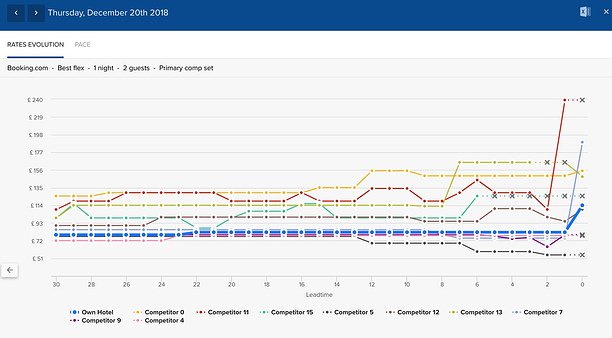
Revenue management is a constant challenge to find the ideal price point that attracts guests and boosts a hotel’s bottom line. And the size of a hotel’s margin is heavily dependent on revenue from a strong pricing strategy.
NB: This is an article from OTA Insight
It won’t have escaped your attention that we’re living in the age of Big Data. Data analysis is increasingly becoming the game-changer in enhancing revenue management strategy, so it’s never been more important to harness its power in helping you price wisely.
With so much data available it’s easy to suffer from analysis paralysis, but helping hoteliers to visualise and leverage data is our speciality at OTA Insight. We’ll give you some tips on which data sources are key to positively impacting your profit margins, as well as which tools are best for leveraging the insights you find.
Which data should I be looking at?
Let’s first refresh ourselves on the KPIs that allow us to evaluate revenue success:
Occupancy rate:
Number of rooms sold / Number of rooms available
Average daily rate (ADR):
Rooms revenue earned / Number of rooms sold
Revenue per available room (RevPAR):
Rooms revenue / Rooms available
In order to move these key metrics and positively impact your bottom line, the following data sources should be considered:
- General PMS data
This data is essential not only to keeping track of reservations, but also shedding light on business segment trends and promotion performance. Business segments are important to your bottom line because questions such as why your guests are travelling, how long they stay, and what days of the week they book on, all affect your demand forecast. Due to the level of data a PMS holds it’s important to ensure it comes with robust reporting functionality.
- Hotel guest data
Usually stored within your PMS, guest data is one of the most invaluable resources a hotel can utilise. Guest data mirrors your PMS data in telling you who your guests are, how long they tend to stay and the purpose of their travel. However, you can take this further with more detailed data on guest preferences. This knowledge can shape your marketing and distribution strategy as it allows for more targeted emails or social campaigns, which should have a positive impact on your conversion rate, thus adding revenue.
Making use of guest data is also important when looking at the distribution landscape and changing the relationship between hotels and OTAs. Whilst personalisation is a method being wielded by both hotels and OTAs, hotels can really drive their direct bookings by using the data to create a personalised experience from booking, right the way to tailored offers for future trips.
- Market intelligence
Along with looking at the data sources you have at your fingertips, you should also be keeping an eye on the level of demand in your market as these insights inform how you set your rates and adjust strategy.
Local events in your area have an impact on demand. You should factor in:
Major events: Large-scale events like the Olympics, Tour de France or the Super Bowl. These are highly publicised so high demand can be forecast well in advance.
Minor events: Smaller, local events such as concerts, industry conferences or government assemblies. These take slightly more effort to look out for, but will definitely affect demand so should be factored into your pricing strategy. To save time, there are some rate shopping tools that signpost local events for you.
Unforeseen events: Sometimes there will be events that can’t be planned for that will require travellers to stay for extra nights – or not book at all. Examples include adverse weather or naturally occurring events like volcano smoke clouds. While you can’t predict when these things will happen, retrospective analysis of the effect on prices is telling; the image below shows the rate evolution of prices at a hotel at London’s Gatwick Airport in late December last year, when flights were grounded after drones were spotted near the runway. (This data is also useful when looking at year-on-year performance.)

Valuable data needs clarity
Powerful data is nothing without tools that enable you to act on your findings. Luckily, there are a number of tools that will allow you to visualise your data and manage it efficiently, meaning that building an optimised pricing strategy doesn’t have to be time-consuming.
The following products belong in any revenue manager’s toolkit:
- Business intelligence
An effective hotel business intelligence tool integrates with your PMS data and allows you to understand your business distribution by analysing booking patterns, lead times and a variety of key factors, including KPIs. The best of these products will present the data in a way that is easy to understand and pass along to your teams.
- Rate shopper
As well as being able to provide access to all relevant factors impacting demand, a rate shopper lets you monitor whether your OTA promotions and marketing campaigns are paying off. A good rate shopper provides benchmarking integration with well-known suppliers such as STR and Benchmarking Alliance. This is key to comparing the pricing strategy of your competition across all key OTAs. There are also rate shoppers that come with parity information, allowing you to track where you might be losing revenue across your OTAs and metasearch channels.
- Channel manager
A channel manager allows you to efficiently manage your inventory across all your booking channels in one place. A channel manager integrated with your PMS is useful because it will also include your direct channel, so when someone books over the phone and the booking is created in your PMS, the inventory is automatically reduced across all your online booking channels.
- Booking engine
An online booking engine is attached to your website and manages your direct online channel. It works much like the booking function on OTA websites, so travellers are comfortable booking through it. A booking engine that integrates with both your PMS and channel manager is helpful because it means that your direct online business’s inventory is automatically managed and updated, and you don’t sell rooms that you don’t have. Your booking engine should also be able to integrate with your rate shopping tool so that you can monitor all of your rates in one place. Having that data in one central location means that you can pick up on any violations of rate parity, and update your rates accordingly – all in real-time.
There we have our breakdown of which data sources can work for you in increasing your bottom line, as well as the analysis tools that make all the difference in visualising and leveraging those insights.




